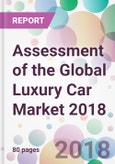As per the manufacturer’s suggested retail price, a luxury car falls into three segments, namely entry-level, midrange and premium. While an entry level luxury car price starts at USD 28,790, price of a vehicle form the premium segment might go up to USD 121,750.
The global luxury car market has seen been relatively untouched by the financial crisis and has been posting growth driven by the emerging markets. The three German players BMW, Audi and Mercedes-Benz account for approximately 80% share of the global luxury car market. BMW is the global leader in the luxury car segment, followed by Mercedes-Benz and Audi. World over while mass automobile manufacturers are struggling with margins, high end manufacturers are enjoying steadily increasing sales.
Our analysts feel that the future of the luxury car segment in China is bright. The consumer confidence is high and despite the Government’s austerity drive the sale of luxury and super luxury vehicles has not slowed down. It is projected that the Chinese car market will grow 3%-5% per year until 2020. With households with incomes over USD 34,000 projected to triple to 23 million by 2020, it is expected that the number of prospective buyers for premium cars in China will grow fast.
Global key luxury car manufacturers are feeling the heat of the trade negotiation between the United States and China. BMW AG expects the United States trade negotiations with China to affect earnings in 2019 by at least USD 1.1 billion. Other factors contributing to this affect include higher commodity prices and foreign exchange movements. As per the November 2018 sales reports, BMW is the second largest luxury car player in the United States, behind Mercedes-Benz. BMW clocked sales of 28,330 vehicles in November while Mercedes-Benz recorded sales of 31,022 vehicles.
Even though 2016 was a challenging year for luxury car manufacturers in India, the players are optimistic now. Mercedes Benz has expressed a confident view of the mid to long-term potential. Similarly, Volvo too is confident and is aiming for a 10% market share by 2020. Winning strategies in the Indian luxury car market include investment in creating clear brand differentiation and launch of newer more compact and sustainable models. It is expected that till 2020 the German firms Audi, BMW, and Mercedes-Benz will be holding close to 80% of the market share.
In the GCC region, the United Arab Emirates is the second-largest automotive market after Saudi Arabia. U.A.E. is heavily dependent upon imports and almost the entire supply of car as well as light vehicles is imported. The low oil prices and global macroeconomic factors are affecting the luxury goods market in the Middle East. While over the last 10 years the personal luxury goods market witnessed an annual growth of 8-10%, it is projected to drop to approximately 4-5% over the next few years. Even amidst the economic slowdown globally, the sales of luxury cars per capita are still the highest in the Middle East.
Our analysts feel that the outlook for the global luxury car sector is bright, lead by growing demand from China and India, and recovering demand from Europe. The outlook for the United States and Middle East luxury car sectors remains moderate.
Why should the report be purchased?
The report ‘Assessment of the Global Luxury Car Market 2018’ highlights key dynamics of the luxury car sector world over. The growing opportunity in the sector has been investigated along with key challenges. Key geographies including the United States, Europe, China, India and the Middle East have been studied in detail and the report covers latest industry numbers and forecasts. The business & financial overview along with the recent developments of all major luxury car manufacturers such as BMW, Daimler, Volkswagen, Tesla, Tata Motors, Porsche and General Motors has been included in the report. The report also contains the opinions of industry stakeholders and experts.
Research methodology and delivery time
The author has conducted in depth secondary research to arrive at key insights. Data collected from key public industry sources and publications has been scanned and analyzed impartially to present a clear picture of the industry. All recent developments which impact the sector dynamics have been captured and used to support the research hypothesis.
The report is available as single-site single-user license. The delivery time for the electronic version of the report is 3 days and dispatch time for hard copies is 4 business days, as each hard copy is custom printed for the client.
This product will be delivered within 2 business days.
Table of Contents
1. Analyst Opinion
Companies Mentioned
- Audi
- Bayerische Motoren Werke AG (BMW)
- Daimler AG
- General Motors Company
- Mercedes-Benz
- Porsche AG
- Tata Motors Limited
- Tesla, Inc.
- Volkswagen AG
- Volvo








